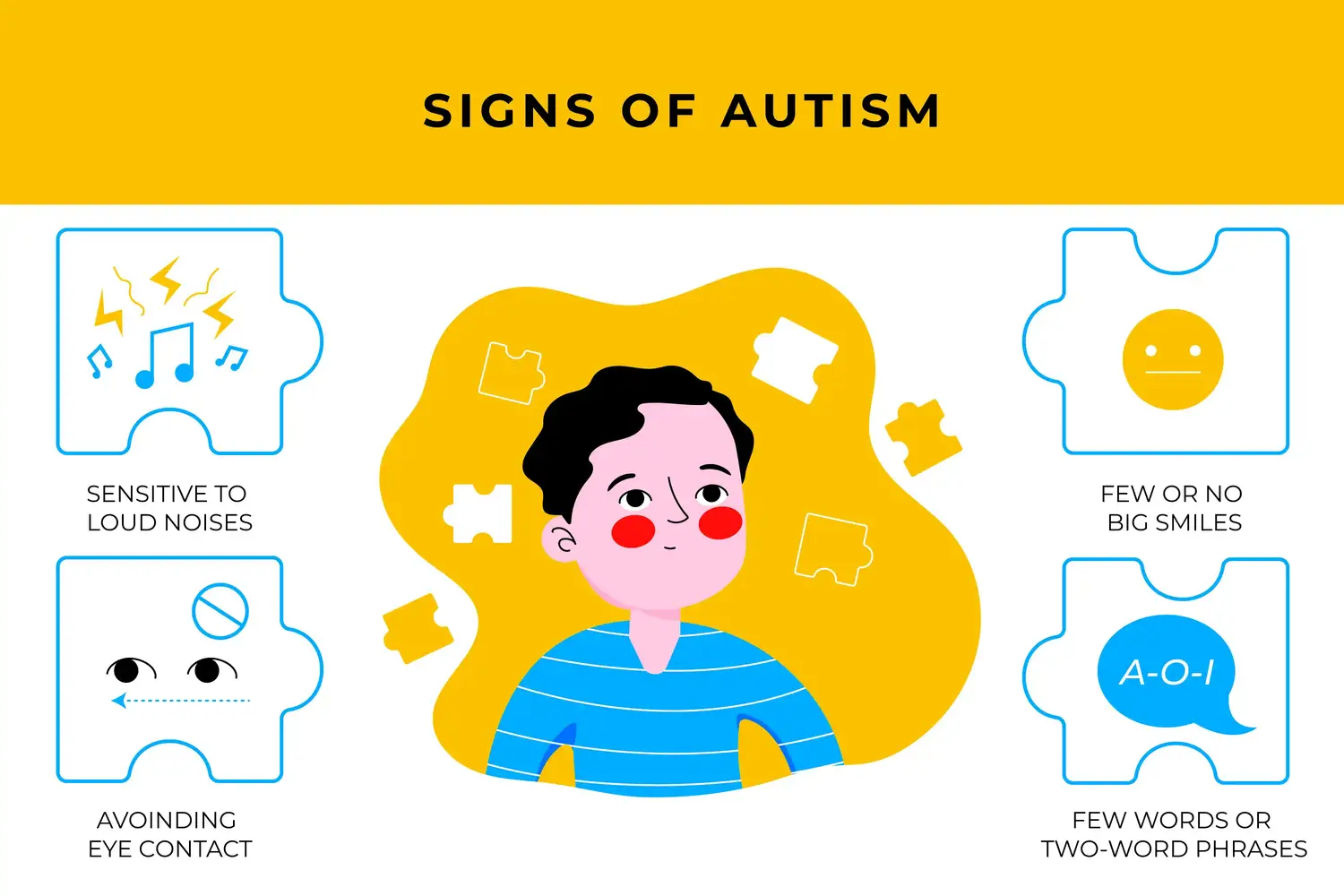Learn about the early signs of autism in toddlers, children, and adults, how behaviours may vary, and when to consider seeking professional support.

Autism Spectrum Disorder (ASD) encompasses a range of conditions characterized by challenges with social skills, repetitive behaviors, and sensory differences. Understanding ASD involves recognizing signs like avoiding eye contact, difficulty in social situations, and engaging in repetitive body movements. Early signs may manifest in young children through delayed developmental milestones. A diagnosis of autism may be made based on various features such as sensory experiences and social communication difficulties. Autistic individuals may require extra support in daily life, including a range of therapies tailored to their unique strengths and challenges.
Autism spectrum disorder is characterized by persistent challenges in social communication and interaction, alongside restricted, repetitive patterns of behavior, interests, or activities. These characteristics typically emerge during early childhood, often becoming apparent before the age of three, as children navigate developmental milestones.
The autism spectrum encompasses a broad range of abilities and challenges. While some individuals with ASD may require significant support in daily living, others may lead relatively independent lives with the right support system. Autism diagnosis involves a comprehensive evaluation by qualified healthcare professionals, considering a child's developmental history, observations, and assessments.
Early identification and intervention are crucial for maximizing the potential of individuals with ASD. Tailored therapies and educational support can help develop social skills, address communication challenges, manage sensory sensitivities, and foster a sense of belonging.
In the past, conditions like Asperger syndrome were diagnosed separately but are now understood to fall under the umbrella term of autism spectrum disorder (ASD). This shift reflects a growing understanding of the continuous nature of ASD, where individuals may exhibit a range of characteristics and severities.
Furthermore, certain genetic conditions, such as fragile x syndrome, can be associated with a higher likelihood of ASD. It's important to note that not all individuals with fragile x syndrome will have ASD, and vice versa.
The recognition that ASD encompasses diverse presentations highlights the importance of individualized assessment and support. By understanding the specific strengths and challenges of each individual, we can provide tailored interventions that promote their overall well-being and empower them to lead fulfilling lives.

Early identification of autism relies heavily on parental observation and awareness of developmental milestones. It's important to remember that autism manifests differently in each child, but certain red flags warrant further evaluation by healthcare professionals.
Early intervention can significantly impact a child's development, and seeking professional help is vital when concerns arise. Parents should feel empowered to consult with their pediatrician or a qualified specialist if they suspect their child might be exhibiting signs of ASD.
Early signs of autism in toddlers can manifest in various aspects of a child's development, particularly in social interaction and communication. For example, a toddler with ASD might exhibit limited eye contact, avoiding looking at faces or engaging in shared gaze with caregivers.
Moreover, delays in language development, such as not babbling by 9-12 months of age or using single words by 16 months, could indicate a potential concern. These speech delays might be accompanied by unusual vocalizations or repetitive use of sounds or phrases.
Furthermore, atypical responses to sensory stimuli, like indifference to loud noises or an unusual fascination with spinning objects, can also be early indicators of ASD. If a toddler displays a combination of these signs, it is essential to seek professional evaluation.
As young children grow older and encounter more complex social situations, the signs of autism might become more apparent, particularly within school-aged children. Difficulties with social interaction can manifest as challenges in making and maintaining friendships, understanding social cues, and engaging in reciprocal conversations.
For instance, a child with ASD might struggle to interpret facial expressions or body language, leading to misinterpretations and difficulties in navigating social interactions. They might also exhibit repetitive behaviors, such as lining up toys, or show an intense fixation on specific topics or objects, making it challenging to connect with peers who don't share these interests.
In academic settings, children with ASD might excel in specific areas while needing extra support in others. Their sensory sensitivities, like finding it difficult to concentrate in busy or noisy classrooms, might also pose challenges. Recognizing and addressing these challenges is crucial for supporting their learning and overall well-being.
While autism is often diagnosed in childhood, some individuals may not receive a diagnosis until adulthood. Symptoms observed in adults can impact their daily routine, work life, and relationships. Difficulties with social communication might manifest as challenges in understanding sarcasm or interpreting subtle social cues, potentially impacting workplace interactions or romantic relationships.
Maintaining a consistent daily routine and having predictable environments can be essential for adults with ASD, as unexpected changes can trigger anxiety and stress. In some cases, adults with ASD might require support from mental health professionals or occupational therapy to develop coping mechanisms and navigate the complexities of adult life.
Recognizing and understanding these challenges is vital for creating a supportive environment where autistic adults feel valued and empowered. Employers, educators, and healthcare providers can all play a role in fostering inclusivity and understanding for autistic individuals.

Communication challenges are a hallmark of autism spectrum disorder, impacting both verbal and nonverbal aspects. For some individuals, this might involve delays in speech development, while others may have difficulty understanding and using nonverbal cues like facial expressions and gestures.
These challenges can lead to misunderstandings, frustration, and social isolation, making it crucial to employ various communication strategies and tools to bridge the gap and foster meaningful interactions. Parents, educators, and therapists can work together to identify and implement effective communication methods tailored to the individual's needs.
Verbal communication challenges in autistic individuals can take various forms. Some might exhibit echolalia, which involves repeating words or phrases verbatim, often without understanding their meaning. This repetition might serve as a self-soothing mechanism or a way to process language.
Others may demonstrate a preference for literal interpretations of language, struggling to comprehend metaphors, jokes, or sarcasm. This can pose challenges in social communication, as they might misinterpret the intended meaning behind these expressions.
Additionally, individuals with ASD might exhibit a monotone voice or speak in a sing-song manner, making it challenging for others to discern emotions or intentions conveyed through their tone of voice. These differences in verbal communication highlight the importance of patience, understanding, and clear communication from those interacting with autistic individuals.
Non-verbal interactions are equally complex, with autistic individuals often finding it challenging to decipher and respond to body language cues. Maintaining eye contact, which is generally considered a sign of attentiveness in social situations, can be difficult and even overwhelming for some people on the autism spectrum.
Gestures, facial expressions, and body posture, which provide nuanced layers of meaning in everyday conversations, might be missed or misinterpreted, leading to social awkwardness or misunderstandings. Instead of relying solely on these subtle cues, it's helpful to communicate directly and provide clear verbal explanations to ensure mutual understanding.
Visual aids, picture exchange systems, or social stories can serve as valuable tools to enhance comprehension and facilitate smoother interactions. Creating a supportive environment that minimizes sensory overload and encourages comfortable communication styles is paramount.
Behavioral patterns in autism often manifest as repetitive movements, strict adherence to routines, and intense interests. These behaviors serve various functions, from regulating emotions and sensory input to providing a sense of predictability and comfort in a world that can feel overwhelming.
While these behaviors are a natural part of the autism spectrum, they can occasionally pose challenges in social settings or interfere with learning. Understanding the purpose behind these behaviors allows us to develop strategies that encourage flexibility and adaptability while respecting the individual's need for routine and structure.
Repetitive behaviors, also known as "stimming," are a common feature of autism, serving multiple purposes in daily life. For many on the spectrum, stimming provides a means of regulating sensory experiences and managing overwhelming emotions.
These repetitive movements can take on various forms, from hand flapping and rocking to spinning objects or repeating phrases. While these behaviors might appear unusual to those unfamiliar with autism, they are not inherently harmful and often serve a valuable function for the individual.
It's essential to approach these behaviors with sensitivity and avoid interrupting or suppressing them unless they pose a risk of harm. Instead, providing alternative outlets for sensory input, such as fidget toys or quiet spaces, can be helpful in managing anxiety and promoting a sense of calm.
Individuals with autism often develop very keen interests and engage deeply in specific hobbies or activities. These interests can provide a source of joy, motivation, and a sense of mastery. While these passions might revolve around subjects or items not typically considered mainstream, encouraging and supporting these interests can foster self-esteem and create opportunities for learning.
The range of interests is vast and varied, just like the autistic community itself. Here are some common areas where autistic individuals demonstrate a particular passion:
Social interactions can be challenging for individuals with autism, who may struggle with understanding and responding to social cues. Navigating the nuances of nonverbal communication, engaging in reciprocal conversations, and understanding social expectations can feel overwhelming.
Building meaningful connections is crucial for well-being, and there are ways to support autistic individuals in developing social skills. Utilizing visual aids, practicing social scenarios, and fostering an inclusive environment that embraces neurodiversity can empower individuals with ASD to form lasting relationships.
One of the hallmarks of autism is difficulty understanding and responding to social cues, which are the subtle signals and unspoken rules that govern social interactions. Recognizing facial expressions, interpreting body language, and understanding the unwritten rules of conversation can be particularly challenging for individuals on the autism spectrum.
This difficulty in processing social information can lead to misinterpretations, missed opportunities for connection, and feelings of social isolation. Bright lights, loud noises, or crowded spaces. This heightened sensitivity can make social situations, which often involve multiple sensory inputs, particularly challenging to navigate.
Creating a supportive environment that minimizes sensory overload and prioritizes clear, direct communication can foster positive social experiences. Using visual supports, such as social stories or picture cards, help to clarify social expectations and provide concrete examples of expected behaviors.
Building and maintaining supportive relationships are essential aspects of a fulfilling life, and for individuals with autism, this can sometimes require extra effort and understanding. Developing social skills, such as initiating conversations, taking turns in interactions, and reading nonverbal cues, can enhance social confidence and foster meaningful connections.
Social skills training programs, support groups, and individual therapy can provide valuable tools and strategies to navigate everyday life interactions. These interventions can focus on practicing conversation starters, interpreting social cues, and understanding appropriate social boundaries.
Equally important is creating an inclusive community that embraces neurodiversity and values the unique perspectives and strengths of autistic individuals. By fostering understanding and acceptance, we can empower individuals with ASD to form lasting friendships, romantic relationships, and supportive social networks.
In conclusion, understanding the signs of autism is crucial for early intervention and support. From communication challenges to behavioral patterns and social interactions, recognizing the diverse characteristics of autism spectrum disorder is vital. By staying informed and promoting acceptance, we can create a more inclusive environment for individuals with autism. If you suspect someone may be showing signs of autism, seek professional guidance for proper diagnosis and tailored care. Remember, each person with autism is unique, and with acceptance and support, they can thrive in their own way. Let's work together to foster a more understanding and compassionate society for all.
What are the first signs of autism in a child?
Early signs often include delayed speech, limited eye contact, difficulty with social interaction, and repetitive behaviors. If you notice any possible signs of autism in your young children, consult with your doctor to discuss concerns and potential next steps. Early intervention is critical.
How is autism diagnosed in Australia?
Autism diagnosis in Australia is a multidisciplinary process, typically involving healthcare professionals experienced in autism spectrum disorder (ASD). They use standardized diagnostic criteria, considering a child's developmental history and the presence of key features of autism.
How is autism diagnosed and by whom?
Autism diagnosis is generally conducted by medical specialists, such as developmental pediatricians or child psychiatrists, who specialize in neurodevelopmental disorders. They evaluate a child's developmental history, observe their behavior, and consider the presence and severity of autism symptoms to make a diagnosis of autism.
Are there different types of autism spectrum disorders?
While terms like "Asperger syndrome" were once used, the current understanding views autism as a spectrum. Individuals can exhibit a wide range of autism characteristics and severities, with strengths and support needs varying greatly.
How can family members and friends support individuals with autism?
Providing understanding, patience, and emotional support are key. Learn about their specific needs and challenges, offer practical help with daily tasks, and celebrate their accomplishments. Encourage and provide access to autism support groups, therapies, or resources.
What are some common misconceptions about autism?
One common misconception is that autistic individuals are unemotional or lack empathy. This is untrue. Public awareness campaigns and access to correct information can help dispel autism myths and foster a more inclusive society.